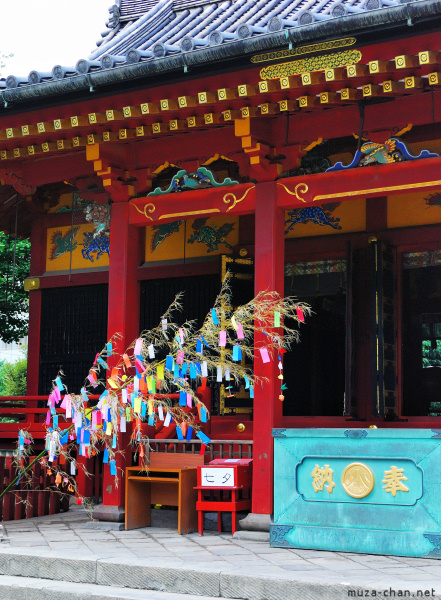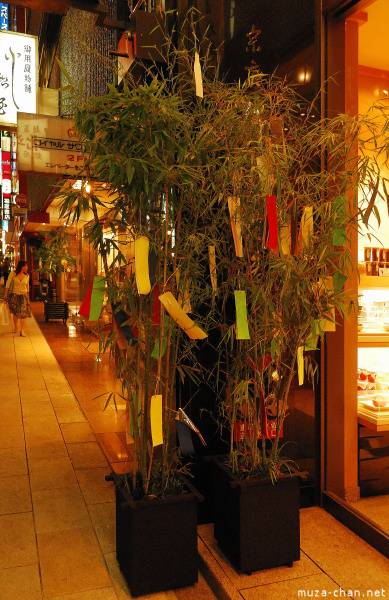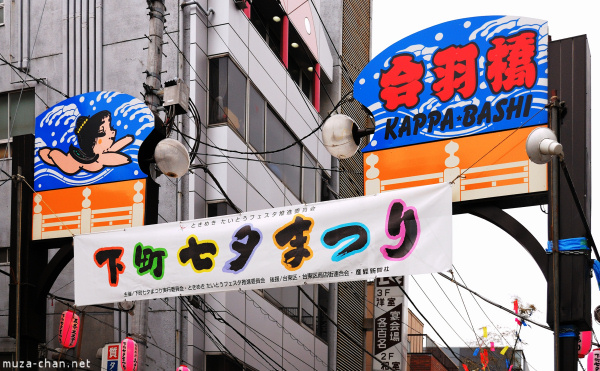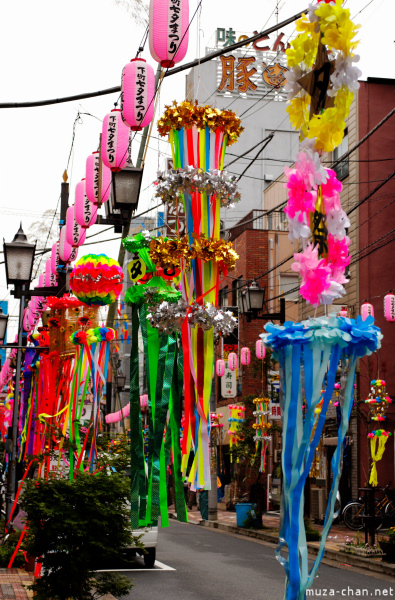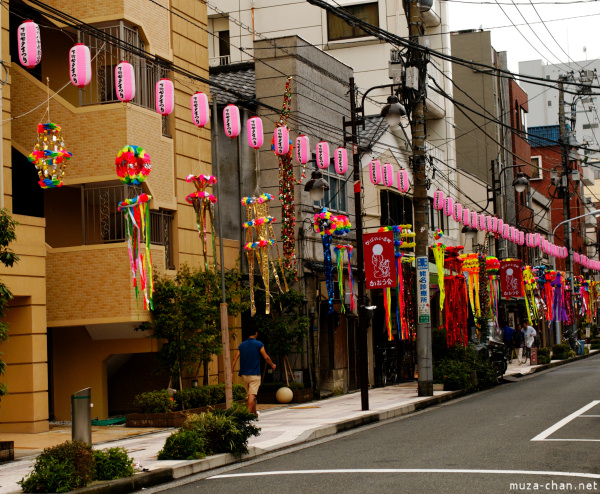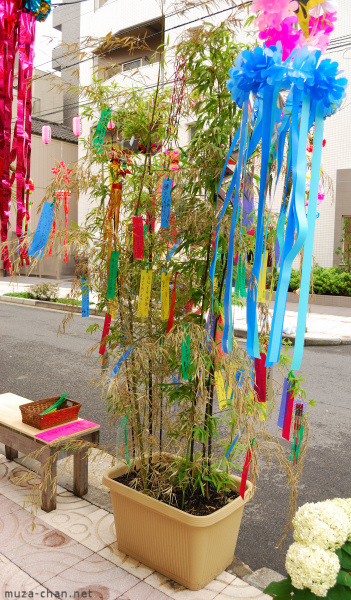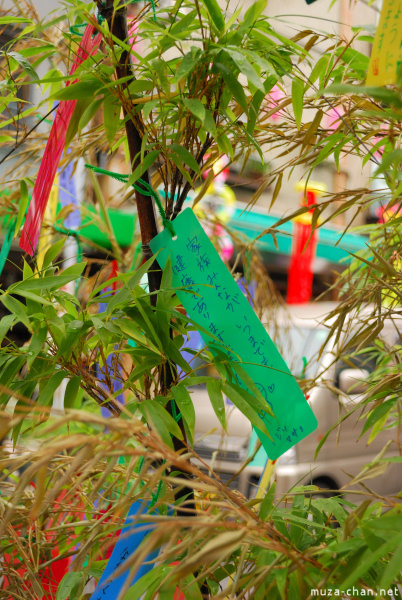I like Japanese festivals, Buddhist and Shinto alike, they transpose me into their magical world, with kami, supernatural beings and romantic stories, they make me see the world with child’s eyes and enjoy simple things.
Perhaps the most romantic of all is the story about the two lovers, Hiko Boshi (Altair) and Orihime Boshi (Vega), who can meet only once a year, on the 7th day of the 7th month, at Tanabata.
The previous day, on 6th July, I went to the Asakusa Shrine, where the bamboo branch was already decorated with many wish notes (tanzaku), in different colors.
I don’t know how it was at the end of the festival, probably loaded with tanzaku, I went to see it the next day but it was already shed on the Sumida river, as customary.
Impresii de călătorie - Tanabata
Sărbătorile japoneze, şi cele de origine budistă şi cele shinto, mă fac să privesc lumea cu ochi de copil şi să mă bucur de lucruri simple, reuşesc să mă transpună în lumea lor magică, cu kami, fiinţe supranaturale şi poveşti romantice.
Poate cea mai romantică dintre toate este povestea despre cei doi îndrăgostiţi, Hiko Boshi (Altair) şi Orihime Boshi (Vega), care se pot întâlni o singură dată pe an, în cea de a şaptea zi a celei de a şaptea luni, de Tanabata.
Cu o zi înainte, pe 6 iulie, fusesem la altarul Asakusa din complexul Senso-ji, unde ramura de bambus pentru Tanabata era deja împodobită cu destul de multe bileţele colorate (tanzaku), pe care erau scrise dorinţe.
Nu ştiu cum a arătat în final, probabil că a fost mult mai încărcată. Am vrut să o văd, dar a doua zi dimineaţa când am ajuns acolo, creanga nu mai era, fusese deja luată şi pusă pe râul Sumida, aşa cum este obiceiul.
Spre seară, plimbându-mă prin Ginza, am văzut că unele dintre magazine aveau aşezate la intrare ghivece cu bambus în care erau agăţate tanzaku.
Clădirile din Ginza arată occidental, străzile sunt largi şi perpendiculare şi doar reclamele în formă de nobori mi-au adus aminte că eram în Japonia. Aici, obiceiul mi-a lăsat impresia de artificial, fabricat, comercial, ca iepuraşul de Paşte. În Asakusa am avut o cu totul altă impresie, mi s-a părut un obicei simplu şi frumos, legat de dorinţe şi de vise care se doresc a fi îndeplinite, aşa cum sunt multe alte obiceiuri în Japonia.
Pe 7 iulie, dis de dimineaţă, m-am dus la centrul de informaţii pentru turişti din Asakusa să aflu programul. Un domn simpatic mi-a spus că în afară de altarul Asakusa, trebuie să vizitez strada Kappabashi, să văd decoraţiile.
Am ajuns la arcada care marchează intrarea în zona comercială şi am văzut anunţul referitor la Tanabata.
De o parte şi de alta a străzii erau multe decoraţiuni din hârtie plastifiată, în culori vii, vesele.
Un lung şir de lanterne din hârtie de culoare roz întregeau atmosfera festivă.
Era încă devreme, aşa că pe stradă erau puţini trecători, doar câţiva vânzători din zonă care priveau decoraţiile.
Strada s-a animat puţin doar când a trecut autobuzul care face turul zonei Asakusa pentru turişti.
M-am oprit în faţa unui magazin, lângă un ghiveci cu bambus în care erau puse câteva tanzaku, iar alături, pe un scăunel, o cutiuţă cu bucăţele de plastic de cinci culori şi câteva pixuri.
M-am oprit să fac o fotografie, proprietarul magazinului m-a văzut, a ieşit şi mi-a arătat tanzaku, explicându-mi în japoneză şi prin semne că mă roagă să-mi scriu o dorinţă. Am fost încântată de idee, mi-am dat imediat seama că îmi doream să fac asta, dar că nu aş fi îndrăznit să o fac din proprie iniţiativă.
I-am mulţumit şi mi-am scris dorinţa pe o bucată de culoare verde. Ştiam ce-mi doresc, nu mi-a trebuit timp de gândire. A stat lângă mine până când am terminat, apoi mi-a arătat cum trebuie să o agăţ. I-am mulţumit încă o dată, mi-a mulţumit şi el şi a intrat râzând în magazin.
În acel moment am fost convinsă că dorinţa mi se va îndeplini… nu mă întrebaţi de ce, pur şi simplu aşa am simţit. Nu încercaţi să înţelegeţi ce scrie, nu am fotografiat dorinţa mea…
Am lăsat in urmă străduţa împodobită de sărbătoare şi m-am întors la hotel.
The same evening, I went for a stroll in Ginza and noticed that, at the entrance of some stores, there were bamboos with tanzaku.
The buildings in Ginza are built in western style, the streets are wide and square, just the commercial signs, shaped like nobori, vaguely reminds of Japan. There, the festival gave me the impression of fake, fabricated, commercial, just like the Easter bunny. At the Asakusa Shrine it was a totally different impression, it looked simple and nice, linked to desires and dreams waiting to be fulfilled, like many festivals in Japan.
On July 7, early in the morning, I went to the Tourist Information Center in Asakusa in search of information. A nice gentleman told me that besides the Asakusa Shrine, I must go to the Kappabashi-dori, to see the decorations.
I arrived at the arcade marking the commercial area and found the Tanabata banners.
Along the street, there were a lot of decorations made from plasticized paper, in happy, bright colors.
Few people were on the street, because it was still early, just some shop owners looking at the decorations.
The street animated a little, when the bus making the tourist tour of Asakusa passed.
I stopped in front of a store, next to a bamboo pot with tanzaku. On a small chair, carefully arranged, there was a little box with plastic cards for the wishes and some ball pens.
I stopped to take a picture and the shop owner went out of the store and showed me a tanzaku, explaining in Japanese and by signs that he wanted me to write a wish. I was thrilled, I immediately realized that I wanted to do this but I didn’t dare.
I thanked him and wrote my wish on a green tanzaku. I already knew my wish, so I didn’t need thinking time. He stood next to me until I finished, then he showed me how to put it on the tree. I thanked him again, he thanked me too and went smiling into the store.
On that moment, I was sure that my wish will be fulfilled, don’t ask me why, I just felt it. By the way don’t try to read it, I didn’t photographed my wish…
I left the decorated street and went back to the hotel.
